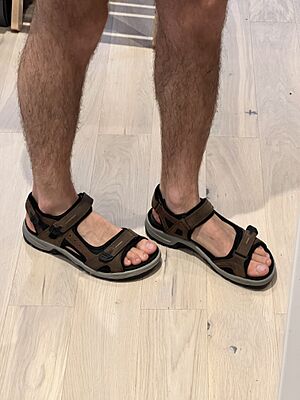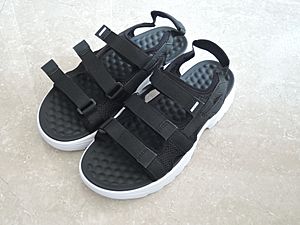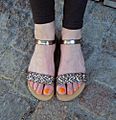Sandal facts for kids
Sandals are a type of open shoe. They have a flat bottom part called a sole that is held to your foot with straps. These straps usually go over the top of your foot and around your ankle. Some sandals even have a heel! What makes sandals special is that they leave most of your foot uncovered.
People wear sandals for many reasons. They are great for warm weather because they keep your feet cool and dry. Sandals often use less material than closed shoes, so they can be cheaper to make. They are also a popular fashion choice. Wearing sandals can even help prevent or treat foot problems like athlete's foot because your feet get more air.
Contents
What Are Sandals?
A sandal is basically a sole attached to your foot. This can be done with a narrow strap that goes between your first and second toe, like on flip-flops. Or, it can be a wider strap or lace that goes over the top of your foot or around your ankle. Sandals can have a low heel, a high heel, or no heel at all. The sole can be made from many different materials like rubber, leather, wood, or even rope.
Where Does the Name "Sandal" Come From?
The word "sandal" comes from old languages. It traveled from Ancient Greek to Latin, then to Middle French, and finally into the English we use today. In ancient times, the Greek and Latin words for sandals often referred to specific styles, especially women's sandals or slippers, rather than all open footwear.
A Long History of Sandals
Sandals are some of the oldest known types of footwear! Scientists found very old sandals made from sagebrush in a cave in Oregon, USA. These sandals are over 10,000 years old!
People in ancient Egypt wore sandals made from palm leaves or papyrus. Rich Egyptians sometimes had sandals decorated with gold. Even Egyptian priests wore papyrus sandals. In Mesopotamia, sandals were often made from rawhide and straw.
In Ancient Greece, there were many kinds of sandals. Some had soles made of wood or leather with straps between the toes and around the ankle. Greek actors wore special sandals. Tragedy actors wore cothurnus, which were like sandal-boots with thick soles to make them look taller.
In ancient Rome, people usually wore sandals or slippers at home because their outdoor shoes (called calcei) were not very comfortable. However, wearing comfortable shoes in public was seen as odd or even rude for important people. So, Romans would often carry their sandals to a friend's house and change into them there for dinner.
In the late 1800s, sandals started to become popular in England. A man named Edward Carpenter learned how to make Indian sandals and began making them for himself and his friends. This led to a small business that grew over time.
Different Kinds of Sandals
There are so many types of sandals, each with its own look and purpose!
- Barefoot sandals: These look like sandals but don't have a sole. They are just decorations for your feet.
- Caligae: These were strong, heavy sandals worn by Roman soldiers for marching.
- Clogs: Some clogs are like heavy sandals, often with a thick wooden sole.
- Fisherman sandals: These have a closed toe area made of woven leather straps. They often have a strap that buckles around the ankle.
- Flip-flops: These are simple, often cheap sandals perfect for the beach or pool. They have a strap that goes between your first and second toe.
- Geta: Traditional Japanese sandals with a raised wooden sole, often with two "teeth" underneath.
- Grecian sandals: These have many straps that crisscross over the foot and sometimes go up the calf. They are also called gladiator sandals.
- High-heeled sandals: Sandals with a raised heel, making them look more formal.
- Hiking sandals: Designed for walking outdoors, these have strong rubber soles and comfortable straps that dry quickly. They are great for adventures like rafting or traveling.
- Ho Chi Minh sandals: These are homemade sandals often made from old car tires for the sole and inner tubes for the straps.
- Huaraches: Mexican sandals, sometimes with soles made from tire treads.
- Jelly sandals: Made from soft PVC plastic, these colorful sandals were first made after World War II when leather was scarce.
- Ojota: Very tough Peruvian sandals made from recycled tires, worn by people in the Andes mountains.
- Paduka: Ancient Indian sandals that have a knob for the big toe instead of straps. They are mostly worn by monks or for ceremonies today.
- Saltwater sandals: Flat sandals, first made in the 1940s, mostly worn by children.
- T-bar sandals: These have a closed heel and toe, with a strap that forms a "T" shape over the top of the foot. They are common for young children.
- Waraji: Japanese straw sandals common during the Edo period.
- Zōri: Flat Japanese sandals with a thong, made from straw, cloth, leather, or rubber.
Images for kids
-
Charlton Heston and Jack Hawkins's caliga sandal-boots from the American film Ben-Hur
See also
 In Spanish: Sandalia para niños
In Spanish: Sandalia para niños
















